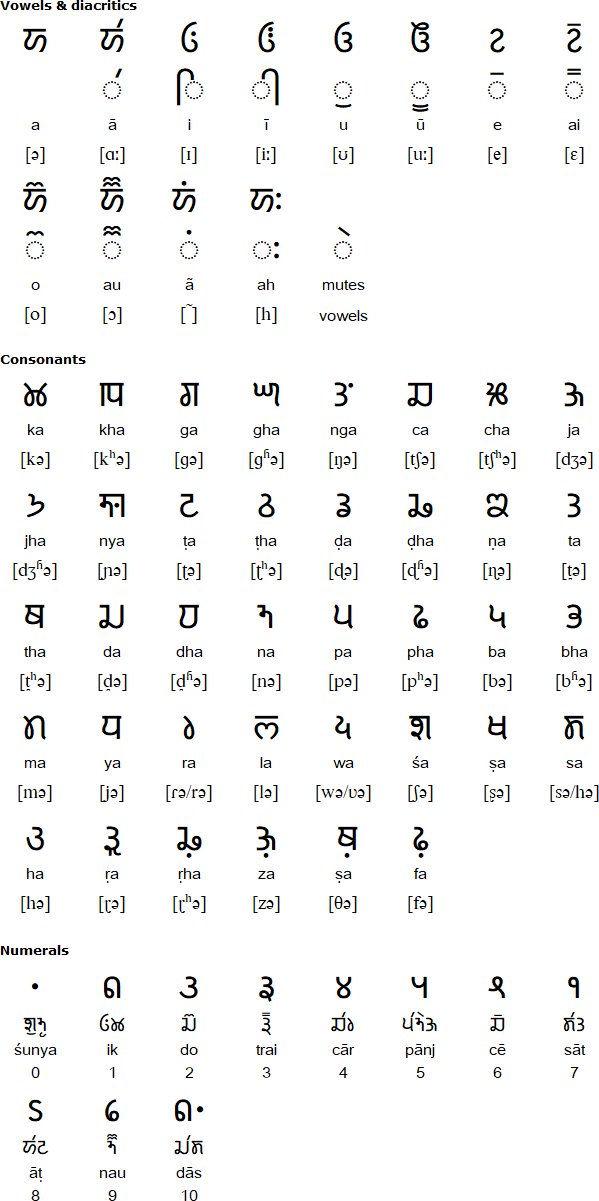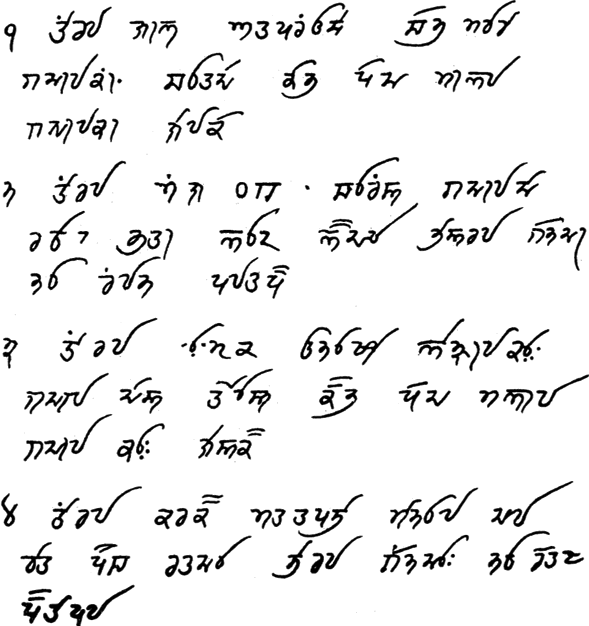The Takri alphabet is a Brahmic alphabet related to the Sharada, Landa and Gurmukhi alphabets, descended from the Devāśeṣa alphabet, which developed from the Sharada alphabet in the 14th century. The Takri alphabet emerged as a distinct script during the 16th century.
Takri was as an official script in parts of north and northwest India from the 17th century until the mid-20th century. A version of Takri was the official script of Chamba State, which is now part of Himachal Pradesh, and was used to write Chambeali. In Jammu and Kashmir a version of Takri known as Dogra Akkhar was used to write Dogri. It was offically adopted in the 1860s, and was replaced by Devanagari in 1944.
Takri was also used on postage stamps and postmarks; for translations of Sanskrit texts into Dogri; for official records, letters and decrees; in inscriptions; for translations of Christian religious texts into Chambeali; on Pahari paintings. It has also been used to write the Gaddi, Jaunsari, Kashtwari, Kulvi and Mandeali languages.
Other names for Takri include Takari, Takkari Tankri and Ṭākarī. The origins of the name are uncertain: one theory is that it is derived from ‘ṭaṅkā (coin). Another theory suggests that the name is connected to ṭakka, the old landed class of Punjab, or that it is the alphabet of the Ṭakkas.
Since Takri fell out of use, efforts have been made to revive it for Dogri Kishtwari and Kulvi in the states of Jammu, Kashmir and Himachal Pradesh, where the local government has set up a programme to train Takri specialists in association with the Indira Gandhi National Open University.
There is considerable regional variation in the Takri alphabet with each state or region have its own version. The version below is are mainly Chambeali versions.

Download an alphabet chart for Takri (Excel)
Details supplied by Biswajit Mandal (biswajitmandal[dot]bm90[at]gmail[dot]com)
See how to write the Takri letters:

Information about the Takri alphabet
https://en.wikipedia.org/wiki/Takri_script
http://www.unicode.org/charts/PDF/U11680.pdf
https://cbkwgl.wordpress.com/2014/10/24/takri-scripts/
Takri font
https://en.fontke.com/font/67620091/download/
Bilaspuri, Dogri, Chambeali, Gaddi, Jaunsari, Kullui, Mandeali, Pangwali, Simauri
Ahom, Aima, Arleng, Badagu, Badlit, Basahan, Balinese, Balti-A, Balti-B, Batak, Baybayin, Bengali, Bhaiksuki, Bhujimol, Bilang-bilang, Bima, Blackfoot, Brahmi, Buhid, Burmese, Carrier, Chakma, Cham, Cree, Dehong Dai, Devanagari, Dham Lipi, Dhankari / Sirmauri, Ditema, Dives Akuru, Dogra, Ethiopic, Evēla Akuru, Fox, Fraser, Gond, Goykanadi, Grantha, Gujarati, Gunjala Gondi, Gupta, Gurmukhi, Halbi Lipi, Hanifi, Hanuno'o, Hočąk, Ibalnan, Incung, Inuktitut, Jaunsari Takri, Javanese, Kaithi, Kadamba, Kamarupi, Kannada, Kawi, Kharosthi, Khema, Khe Prih, Khmer, Khojki, Khom Thai, Khudabadi, Kirat Rai, Kōchi, Kodava Lipi, Komering, Kulitan, Kurukh Banna, Lai Tay (Tai Yo), Lampung, Lanna, Lao, Leke, Lepcha, Limbu, Lontara/Makasar, Lota Ende, Magar Akkha, Mahajani, Malayalam, Meitei (Modern), Manpuri (Old), Marchen, Meetei Yelhou Mayek, Meroïtic, Masarm Gondi, Modi, Mon, Mongolian Horizontal Square Script, Multani, Nandinagari, Newa, New Tai Lue, Ojibwe, Odia, Ogan, Pahawh Hmong, Pallava, Phags-pa, Purva Licchavi, Qiang / Rma, Ranjana, Rejang (Kaganga), Sasak, Savara, Satera Jontal, Shan, Sharda, Sheek Bakrii Saphaloo, Siddham, Sinhala, Sorang Sompeng, Sourashtra, Soyombo, Sukhothai, Sundanese, Syloti Nagri, Tagbanwa, Tai Noi, Takri, Tamil, Tanchangya (Ka-Pat), Tani, Thaana, Telugu, Thai, Thirke, Tibetan, Tigalari, Tikamuli, Tocharian, Tolong Siki, Vatteluttu, Warang Citi
Page last modified: 25.04.24
[top]
You can support this site by Buying Me A Coffee, and if you like what you see on this page, you can use the buttons below to share it with people you know.

If you like this site and find it useful, you can support it by making a donation via PayPal or Patreon, or by contributing in other ways. Omniglot is how I make my living.
Note: all links on this site to Amazon.com, Amazon.co.uk
and Amazon.fr
are affiliate links. This means I earn a commission if you click on any of them and buy something. So by clicking on these links you can help to support this site.
[top]